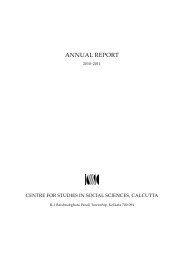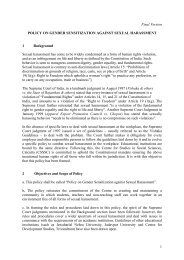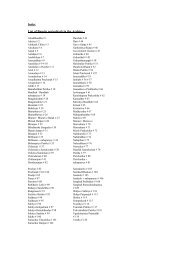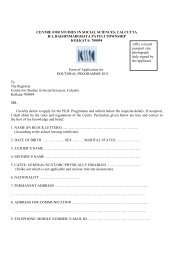papers are i) “Choice, life and the (m)other: towards ethics <strong>in</strong>/of abortion” <strong>in</strong>Human Rights and Ethics: Conceptual Analysis and Contextual Obligations.,Shashi Motilal, (ed) Anthem Press, an academic impr<strong>in</strong>t of WimbledonPublish<strong>in</strong>g Company ii) “The History of <strong>Calcutta</strong> Medical College” (coauthoredby Samita Sen) <strong>for</strong> the book Science and Modern India: AnInstitutional History c. 1784-1947, ed., Uma Dasgupta, PHISPC (Project ofHistory of Indian Science, Philosophy and Culture) series; iii) , “Aestheticiz<strong>in</strong>gLaw <strong>in</strong>to Justice: The Fetus <strong>in</strong> a Divided Planet” <strong>in</strong> a volume of essays onAesthetics and the Representation of Justice to be edited by Etienne Balibar,and Ranabir Samaddar; iv) A different version of “Sexual Difference <strong>in</strong>Literary Historiography: Writ<strong>in</strong>g the Nation <strong>in</strong> “My Life”” was submitted toInterventions: International Journal of Postcolonial <strong>Studies</strong>. The peer reviewsare favourable and he is currently mak<strong>in</strong>g the f<strong>in</strong>al changes <strong>for</strong> publication.Keya Dasgupta has been associated with a project on a comparative studyof three Indian and three South African cities on “Participation and UrbanGovernance <strong>in</strong> India and South Africa”, taken up by the <strong>Centre</strong> de <strong>Sciences</strong>,Huma<strong>in</strong>es de New Delhi. The work has been completed. Her owncontributions to the project are papers on: i) The Hawkers’ Movement <strong>in</strong>Kolkata; ii) Interrogat<strong>in</strong>g the Right to the City: Community Participation andthe Spaces of the ‘Legal’ <strong>in</strong> Contemporary Kolkata; iii) Between the Spacesof the Invented and Invited: The Politics of Negotiation <strong>in</strong> ContemporaryKolkata; and iv) From participation to research: Three divergent perspectives<strong>in</strong> Contemporary Kolkata. She also prepared, as part of this project, a seriesof maps on developments <strong>in</strong> Contemporary Kolkata. The themes rangedfrom the city’s land-use; electoral behaviour; planned projects; sites ofeviction/protest; sites of selected development projects; sites of land usechanges: from <strong>in</strong>dustry to real estate, from bazaars to malls; etc. MollicaDastider completed three papers on i) Liberal Dilemma with Difference:Muslims <strong>in</strong> a Western Democracy to be published <strong>in</strong> CSSSC OccasionalPaper No. 179; ii) Refus<strong>in</strong>g to Choose: The Muslim Madhesis and theCoexistence of Religious and Regional <strong>in</strong> Nepal’s Tarai which will appearas a chapter <strong>in</strong> the <strong>for</strong>thcom<strong>in</strong>g Book: Nationalism and Ethnic Conflict Editedby Susan Hangen and Mahendra Lawoti, Taylor and Francis (Routledge)London; iii) “Voices from the Marg<strong>in</strong>s: The Deconstruction of caste Nepaliculture <strong>in</strong> East Himalayas” to be published <strong>in</strong> <strong>Social</strong> Science Prob<strong>in</strong>gs, NewDelhi <strong>in</strong> their <strong>for</strong>thcom<strong>in</strong>g Special Issue on M<strong>in</strong>orities. Soh<strong>in</strong>i Guhacompleted two papers on i) Multiethnic Trans<strong>for</strong>mation and AsymmetricRepresentation: The Bahujan Samaj Party <strong>in</strong> North India and ii) EmbeddedParties and Democratization: Explor<strong>in</strong>g the Association Anew. ManabiMajumdar has almost completed a book manuscript (jo<strong>in</strong>tly with Jos Mooij)on education and <strong>in</strong>equality <strong>in</strong> India. In addition to the chapters written be<strong>for</strong>e,she has worked particularly on two aspects. First, she has done an analysisof a few sets of textbooks that are used <strong>in</strong> primary classes <strong>in</strong> the State ofWest Bengal, mak<strong>in</strong>g an argument about a k<strong>in</strong>d of synergy between qualityand equality issues. Second, draw<strong>in</strong>g upon the research <strong>in</strong> the States ofAndhra Pradesh and West Bengal, she has explored the idea of educationalactivism and counter-power that may work to challenge the tight l<strong>in</strong>k betweeneducation and power. Priya Sangameswaran made a brief <strong>for</strong>ay <strong>in</strong>to twotopics – environmental security and corruption, each of which resulted <strong>in</strong> apaper. The paper on environmental security titled Extend<strong>in</strong>g the SecurityDiscourse to the Environment and Water was presented <strong>in</strong> a conferenceorganized by Maulana Abdul Kalam Azad Institute of Asian <strong>Studies</strong>, Kolkata<strong>in</strong> collaboration with the <strong>Centre</strong> <strong>for</strong> <strong>Social</strong> <strong>Sciences</strong> and Humanities,University of <strong>Calcutta</strong> and will be published shortly <strong>in</strong> Asia Annual <strong>2009</strong>.The paper on corruption, titled Corruption <strong>in</strong> the Age of Neoliberalism: TheCase of Rural Dr<strong>in</strong>k<strong>in</strong>g Water Projects <strong>in</strong> Western India was prepared <strong>for</strong>the CODESRIA/SEPHIS Equity Policy Dialogue on ‘Corruption: CriticalPerspectives from the South’, October 1-3, 3009 and would be publishedas part of a book be<strong>in</strong>g brought out by SEPHIS.ONGOING PROJECTSEconomicsPranab Kumar Das is currently work<strong>in</strong>g on f<strong>in</strong>ancial system architecture ofSouth and South East Asia. This study perta<strong>in</strong>s to the nature of the coevolutionof different <strong>in</strong>stitutions of the f<strong>in</strong>ancial system, such as banks,stock market, <strong>in</strong>surance companies and the nature of causal relations amongthemselves and with the real sector. The development of an econometricmodel to capture the commonalities and differences across countries <strong>in</strong> acommon framework has been completed. The estimation and <strong>in</strong>ferenceare underway. This will help build up a theory of comparative f<strong>in</strong>ancial systemof the develop<strong>in</strong>g and emerg<strong>in</strong>g market economies which is an open areaof research <strong>in</strong> the filed. He is also work<strong>in</strong>g on a model of exchange ratedynamics and external capital <strong>in</strong>flow which is a jo<strong>in</strong>t work with Gopal KirshnaBasak of the Stat.-Math Unit of Indian Statistical Institute, Kolkata. In thiswork they tried to capture the terms of trade effect of capital <strong>in</strong>flow on theexchange rate and external <strong>in</strong>terest rate <strong>in</strong> a multi period framework.Apart from the above mentioned research he is cont<strong>in</strong>u<strong>in</strong>g his work on firm<strong>in</strong>vestment <strong>in</strong> India. He has been work<strong>in</strong>g on a small paper on R&D4 5
<strong>in</strong>vestment <strong>in</strong> an imperfect credit market set up. Jyotsna Jalan is work<strong>in</strong>gon a research project funded by the Sir Ratan Tata Trust (SRTT), Mumbaithat is near completion. The f<strong>in</strong>al report will be submitted to the fund<strong>in</strong>gagency <strong>in</strong> July. Saibal Kar is now work<strong>in</strong>g on the follow<strong>in</strong>g themes –i) HumanCapital Formation, Occupational Choice and the Labor Market – A SyntheticReview; ii) The Multi Fibre Arrangement and South Asia (with MausumiKar); iii)In<strong>for</strong>mal Sector and the Develop<strong>in</strong>g World: Relat<strong>in</strong>g Theory andEvidence (with Sugata Marjit); v).Wage Differential and corruption. IndrajitMallick is work<strong>in</strong>g now on two projects, i)the Design of ManagementContract with Ex Ante and Ex Post Conflict and ii) Management Screen<strong>in</strong>gContracts under Bankrupty Law. Sugata Marjit is now work<strong>in</strong>g on four newprojects i) A Macroeconometric Model <strong>for</strong> India: The Credit View (with SaibalKar and Pranab Kumar Das),; ii) Recession <strong>in</strong> the Skilled Sector andImplications <strong>for</strong> In<strong>for</strong>mal Wage (with Saibal Kar and S. Chaudhury) and iii)Emigration, Unemployment and Welfare:Role of Non-traded Sector (withSaibal Kar and B.Hazari) and Conflict<strong>in</strong>g Measures of Poverty andInadequate sav<strong>in</strong>gs to the Poor-The Role of a Status Driven Utility Function(with Ranjan Ray).HistoryGautam Bhadra is work<strong>in</strong>g on the social history of the Bengali Almanacs.Initial result of the researches would be <strong>in</strong>corporated <strong>in</strong> his <strong>for</strong>th-com<strong>in</strong>gbook. Tapati Guha-Thakurta is cont<strong>in</strong>u<strong>in</strong>g her work on the book project,Durga Puja <strong>in</strong> Contemporary <strong>Calcutta</strong>.As the writ<strong>in</strong>g of the proposed bookproject has taken longer than anticipated, the field-work and photographicdocumentation on this project was extended <strong>in</strong>to the season of <strong>2009</strong>. Severalchapters of the book, titled, The Aesthetics of a Public Festival: Durga Puja<strong>in</strong> Contemporary <strong>Calcutta</strong>, has been written, and the rema<strong>in</strong><strong>in</strong>g chaptersare to be completed soon, and the book manuscript would be ready by theend of 20<strong>10</strong>. She has been direct<strong>in</strong>g and coord<strong>in</strong>at<strong>in</strong>g all the activities ofthe Ford Foundation project on “A Cultural History Archive on Eastern India”.The project is now <strong>in</strong> its f<strong>in</strong>al year and will term<strong>in</strong>ate <strong>in</strong> February 2011. As apart of the proposed project activities, she is work<strong>in</strong>g on an exhibition onhistorical and contemporary <strong>Calcutta</strong> out of the CSSSC’s archival collection,to be held <strong>in</strong> February- March 2011. Samarpita Mitra.is now work<strong>in</strong>g ontwo papers, i) BaEgadarœana — its <strong>in</strong>tervention, legacy and the emergentliterary sphere <strong>in</strong> f<strong>in</strong>-de-siècle Bengal and ii) Towards a History of PeriodicalReadership <strong>in</strong> Early Twentieth Century Bengal: The Case of RamanandaChattopadhyay’s Prabâsî .Society, Politics, Culture and EnvironmentSibaji Bandyopadhyay is prepar<strong>in</strong>g the manuscripts <strong>for</strong> six books 1)Reader: An Anthology of ten essays <strong>in</strong> English of about 700 pages. Be<strong>in</strong>g a‘Reader’ the book will cover a broad range of topics. It is almost ready andthe f<strong>in</strong>al-copy will be submitted by September 20<strong>10</strong>. Worldview Publications(An Impr<strong>in</strong>t of Book Land Publish<strong>in</strong>g Co.), New Delhi, will publish the‘Reader’. Formalities regard<strong>in</strong>g the contract have been completed; 2)L<strong>in</strong>eages of Post Colonial Modernity <strong>in</strong> Bengal (Tentative title). The bookwill be an anthology of n<strong>in</strong>e essays of about 300 pages <strong>in</strong> English. Broadlydeal<strong>in</strong>g with the question of ‘modernity’ the book will <strong>in</strong>clude essays onBankimchandra Chattopadhyay, Rab<strong>in</strong>dranath Thakur, ManikBandyopadhyay, Satyajit Ray, Ritwik Ghatak and writers engaged <strong>in</strong> theproduction of ‘popular’ literature. All the essays are written. But they needto be revised. Also an ‘Afterword’ has to be added. He hopes to submit thef<strong>in</strong>al-copy by September 20<strong>10</strong>. Tulika Books, New Delhi, will publish the‘Reader’. Formalities regard<strong>in</strong>g the contract have been completed. 3) TheColonial Chronotope (tentative title). The book will be an anthology of threeessays of about 250 pages <strong>in</strong> English. The essays are already written andpublished. But he needs to go over them aga<strong>in</strong> be<strong>for</strong>e submitt<strong>in</strong>g themanuscript to the publisher. They are 1)‘East’ Meet<strong>in</strong>g ‘West’: A Note onthe Colonial Chronotope; 2) Macaulay and Rammohun: ‘Free Market’ andPedagogy;3)Produc<strong>in</strong>g and Re-produc<strong>in</strong>g the New Woman: A note on theprefix ‘re’. <strong>Social</strong> Science Press, Delhi, will publish the book. Formalitiesregard<strong>in</strong>g contract have been completed. 4) A book <strong>in</strong> Bangla of about 250pages on Jibanananda the poet, the novelist and the short-story writer.Presently he is go<strong>in</strong>g over the proofs. He plans to submit the f<strong>in</strong>al manuscript<strong>in</strong> the year 20<strong>10</strong>. Gangchil, Kolkata, will publish the book. Formalitiesregard<strong>in</strong>g contract have been completed.5) A book <strong>in</strong> Bangla of about 200pages on the semantic mutations of the words ‘revolution’ and ‘biplab’. Heplan to develop the Key-note Address which he gave at the sem<strong>in</strong>ar on‘Technologies of Revolution’ organized by Barasat Government College onMarch 4, 20<strong>10</strong>. The Book should be ready by January 2011. Gangchil,Kolkata, will publish the book. Formalities regard<strong>in</strong>g contract have beencompleted. 6) Undated: Nightsk<strong>in</strong>: A book conta<strong>in</strong><strong>in</strong>g my essay <strong>in</strong> Englishon Chittrovanu Mazumdar’s Installation-Work titled Undated: Nightsk<strong>in</strong> anda collage to be prepared by Chittrovanu Mazumdar. The essay is half-written;He hope to complete it soon. The book is still at the plann<strong>in</strong>g stage. He isjo<strong>in</strong>tly edit<strong>in</strong>g with Ar<strong>in</strong>dam Chakrabarti and Sanjay Palshikar an anthologyof essays titled Mahâbhârata Today: Narration, Aesthetics, Ethics to be6 7
- Page 2 and 3: CENTRE FOR STUDIES IN SOCIAL SCIENC
- Page 4 and 5: THE CENTREThe Centre for Studies in
- Page 8 and 9: ought out by Centre for Advanced St
- Page 10 and 11: Dr. Sumit Majumdar, a health econom
- Page 12 and 13: After Dr. Parayil’s resignation,
- Page 14 and 15: in remote areas and planning to dig
- Page 16 and 17: Date Speaker Topic03.12.09 Philippe
- Page 18 and 19: Geography, Education, Rural Develop
- Page 20 and 21: The workshop provided the young res
- Page 22 and 23: Name of Scholar UniversityBiswajit
- Page 24 and 25: Rosinka Chaudhuri taught PG I and P
- Page 26 and 27: 2. ‘From Spectacle to Art: The Ch
- Page 28 and 29: coordinator of i) Research Training
- Page 30 and 31: New Delhi in November 2009. He also
- Page 32 and 33: continuing as a guest columnist of
- Page 34 and 35: fund available from the Endangered
- Page 36 and 37: B. N. Mukherjee & Co.CHARTERED ACCO
- Page 38 and 39: CENTRE FOR STUDIES INR-1, BAISHNABG
- Page 40 and 41: CENTRE FOR STUDIES INR-1, BAISHNABG
- Page 42 and 43: CENTRE FOR STUDIES INR-1, BAISHNABG
- Page 44 and 45: CENTRE FOR STUDIES INR-1, BAISHNABG
- Page 46 and 47: SCHEDULE 4 - SECURED LOANS AND BORR
- Page 48 and 49: CENTRE FOR STUDIES INR-1, BAISHNABG
- Page 50 and 51: CENTRE FOR STUDIES INR-1, BAISHNABG
- Page 52 and 53: CENTRE FOR STUDIES INR-1, BAISHNABG
- Page 54 and 55: CENTRE FOR STUDIES INR-1, BAISHNABG
- Page 56 and 57:
CENTRE FOR STUDIES INR-1, BAISHNABG
- Page 58 and 59:
CENTRE FOR STUDIES INR-1, BAISHNABG
- Page 60 and 61:
CENTRE FOR STUDIES INR-1, BAISHNABG
- Page 62 and 63:
CENTRE FOR STUDIES INR-1, BAISHNABG
- Page 64 and 65:
CENTRE FOR STUDIES INR-1, BAISHNABG
- Page 66 and 67:
CENTRE FOR STUDIES INR-1, BAISHNABG
- Page 68 and 69:
B. N. Mukherjee & Co.CHARTERED ACCO
- Page 70 and 71:
CENTRE FOR STUDIES INR-1, BAISHNABG
- Page 72 and 73:
B. N. Mukherjee & Co.CHARTERED ACCO
- Page 74 and 75:
CENTRE FOR STUDIES INR-1, BAISHNABG
- Page 76 and 77:
CENTRE FOR STUDIES INR-1, BAISHNABG
- Page 78 and 79:
CENTRE FOR STUDIES INR-1, BAISHNABG
- Page 80 and 81:
CENTRE FOR STUDIES INR-1, BAISHNABG
- Page 82 and 83:
APPENDIX - IIBoard of Governors
- Page 84 and 85:
APPENDIX - IIIMembers of the Academ








